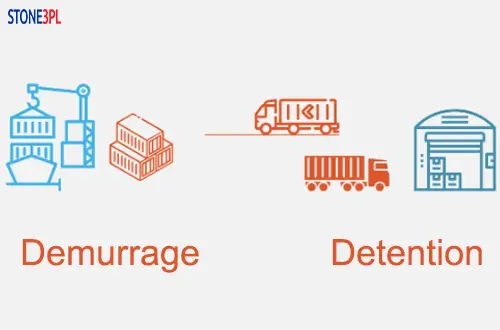A Guide on How to Avoid Demurrage and Detention Extra Charges
Table of Contents
Detention fees and demurrage fees are two concepts that often confuse people when it comes to international logistics and container shipping. Let’s take a closer look at the differences between the two so that you can have a clearer grasp of what they mean in real-life communications.

Definition of Demurrage and Demurrage
What is a demurrage fee?
Demurrage fees apply to containers whose cargo is not picked up from the terminal or port within the scheduled time. Many importers offer a certain number of free storage days for containers and cargo. After this period, demurrage charges will begin.
Ports and terminals handle large amounts of cargo coming in and out every day. When cargo sits immobile, it takes up space and affects operational capabilities. The purpose of demurrage is to encourage shippers to avoid delivering cargo to the port prematurely and to remove it from the port as quickly as possible.
What is a Detention Fee?
Detention fees apply from the time your goods leave the port until the empty container is returned. When the container is picked up, no matter whether it is empty or not using the carrier's equipment, you will be charged a demurrage fee as long as the specified "free time" is exceeded.
Key Differences between Demurrage and Demurrage
The demurrage fee applies to containers in the port and is calculated from the time the ship arrives at the port or the container is unloaded until the container is picked up.
The Detention Fee applies to containers outside ports and facilities, starting when the consignee picks up a fully loaded container and ending when an empty container is returned to the container yard.
How demurrage and demurrage affect international logistics prices
Increased operating costs
When containers are not returned from the port or cleared within the stipulated free time, shipping lines charge port authorities and terminals demurrage and demurrage charges. These additional costs are factored into the total shipping charges charged to shippers and importers/exporters.
risk mitigation
To offset the potential financial risks associated with demurrage and demurrage, shipping lines incorporate these costs into their freight calculations as a risk mitigation strategy.
The higher the perceived risk, the higher the shipping cost.
Operational inefficiency
Delays caused by containers sitting idle in ports or not being returned in a timely manner can undermine shipping lines’ operational efficiency. To compensate for these inefficiencies and maintain service levels, they may increase shipping costs.
Supply and demand dynamics
Overdue container demurrage increases port congestion and may affect the overall supply of containers.
Shipping lines may increase shipping rates to balance supply and demand, especially during peak seasons.
transparency and communication
Effective communication between supply chain parties is crucial to avoid demurrage and demurrage charges.
Shipping lines may consider the potential costs incurred due to poor communication or lack of transparency in shipping rates.
Demurrage and container demurrage are fees established to maintain the flow of goods within and outside the port. But it means additional costs and risks for shipping companies, which they often pass on to customers through higher international logistics prices or freight rates to maintain profitability and operational efficiency.
Common Strategies to Reduce Demurrage and Demurrage Fees
Optimize supply chain management
Ensure timely arrival and transportation of goods through accurate supply chain planning and forecasting. This includes close collaboration with suppliers, freight forwarders and shipping lines to optimize the loading, transport and unloading of goods.
Optimize container utilization
Adopt modes such as cargo owners’ own containers to improve container utilization, return empty containers in a timely manner, and avoid demurrage fees.
Reasonable reservations and arrangements
Make an appointment with a freight forwarder, shipping company or port operator in advance to ensure cargo can be loaded and unloaded within the scheduled time. This helps avoid additional costs incurred by waiting for loading and unloading.
Use efficient packaging and loading techniques
By using appropriate packaging materials and loading techniques, container loading can be maximized and the number of containers required can be reduced, thereby reducing demurrage and detention charges.
Choose the right shipping method
Choose the appropriate transportation method, such as sea, air or land transportation, based on factors such as the nature of the goods, destination and delivery time. This helps ensure your shipment reaches its destination on time and avoids additional costs due to shipping delays.
Logistics partner
Establishing long-term relationships with reputable and highly professional logistics companies, such as stone3pl, can ensure better service and support and reduce additional costs due to transportation issues.
Develop emergency plans
Develop contingency plans for possible delays and losses so that measures can be taken quickly to reduce additional costs when problems occur.
Through the comprehensive application of these strategies, Demurrage fee completes customs clearance procedures in advance and picks up the goods as soon as possible. The Detention Fee ensures that empty boxes are returned on time, avoiding additional costs due to delays. International logistics companies can minimize detention and demurrage fees and improve operational efficiency and profitability. Take a series of strategies to optimize the logistics process.
